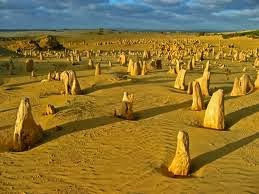Pinanncles Desert
The Pinanncles Desert
By darmansjah
If you want to see the natural wonders of limestone, compaction to please you pinnancles desert. Here there are hundreds of natural limestone as high as five meters 25,000-30,000 years old. The place is very beautiful views, especially when the sun sets.
The raw material for the limestone of the Pinnacles came from seashells in an earlier epoch rich in marine life. These shells were broken down into lime rich sands which were blown inland to form high mobile dunes.
The mechanisms through which the Pinnacles were formed from this raw material are the subject of some controversy, with three mechanisms having been proposed:
They were formed from lime leaching from the aeolian sand (wind-blown sand) and by rain cementing the lower levels of the dune into a soft limestone. Vegetation forms an acidic layer of soil and humus. A hard cap of calcrete develops above the softer limestone. Cracks in the calcrete are exploited by plant roots. The softer limestone continues to dissolve and quartz sand fills the channels that form. Vegetation dies and winds blow away the sand covering the eroded limestone, thus revealing the Pinnacles.
They were formed through the preservation of cast of trees buried in coastal aeolianites where roots became groundwater conduits, resulting in precipitation of indurated (hard) calcrete. Subsequent wind erosion of the aeolianite would then expose the calcrete pillars.
 On the basis of the mechanism of formation of smaller “root casts” occurring in other parts of the world, it has been proposed that plants played an active role in the creation of the Pinnacles, rather than the rather passive role detailed above. The proposal is that as transpiration draws water through the soil to the roots, nutrients and other dissolved minerals flow toward the root. This process is termed "mass-flow" and can result in the accumulation of nutrients at the surface of the root, if the nutrients arrive in quantities greater than needed for plant growth. In coastal aeolian sands which have large amounts of calcium (derived from marine shells) the movement of water to the roots would drive the flow of calcium to the root surface. This calcium accumulates at high concentrations around the roots and over time is converted into a calcrete. When the roots die, the space occupied by the root is subsequently also filled with a carbonate material derived from the calcium in the former tissue of the roots and possibly also from water leaching through the structures. Although evidence has been provided for this mechanism in the formation of root casts in South Africa, evidence is still required for its role in the formation of the Pinnacles.
On the basis of the mechanism of formation of smaller “root casts” occurring in other parts of the world, it has been proposed that plants played an active role in the creation of the Pinnacles, rather than the rather passive role detailed above. The proposal is that as transpiration draws water through the soil to the roots, nutrients and other dissolved minerals flow toward the root. This process is termed "mass-flow" and can result in the accumulation of nutrients at the surface of the root, if the nutrients arrive in quantities greater than needed for plant growth. In coastal aeolian sands which have large amounts of calcium (derived from marine shells) the movement of water to the roots would drive the flow of calcium to the root surface. This calcium accumulates at high concentrations around the roots and over time is converted into a calcrete. When the roots die, the space occupied by the root is subsequently also filled with a carbonate material derived from the calcium in the former tissue of the roots and possibly also from water leaching through the structures. Although evidence has been provided for this mechanism in the formation of root casts in South Africa, evidence is still required for its role in the formation of the Pinnacles.Tourism
The Pinnacles remained unknown to most Australians until the 1960s, when the area was dismissed to Nambung National Park. The area receives over 250,000 visitors a year. A visitor precinct and interpretive centre was completed in March 200.
The best season to see the Pinnacles is spring from August to October, as the days are mild and wildflowers start to bloom. The pinnacle formations are best viewed in the early morning or late afternoon as the play of light brings out the colours and the extended shadows of the formations delivers a contrast that brings out their features. Most animals in the park are nocturnal, but emus and kangaroos can be seen during the daytime, more commonly in the evening or early morning.




0 comments:
Post a Comment